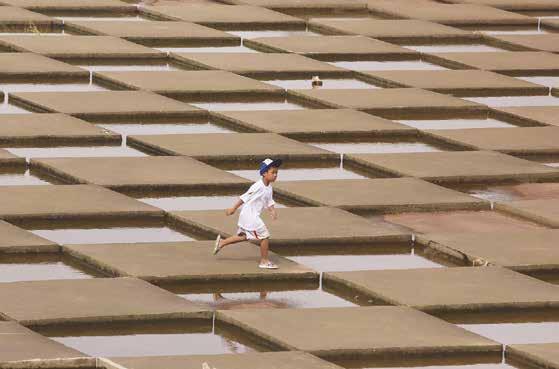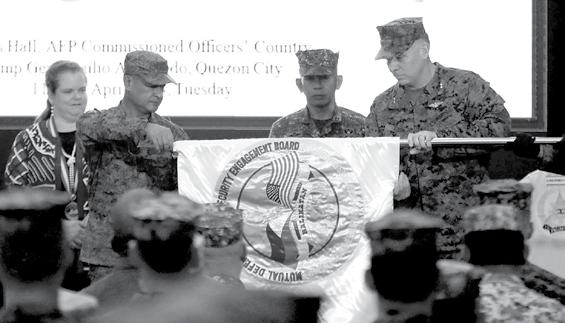
6 minute read
Marcos admin urged to prepare for El Niño, go beyond monitoring dam water
MANILA — Lawmakers have urged the Marcos administration to plan ahead of the possible El Niño-induced water shortages this year to prevent widescale production losses in the agricultural sector.
Recto also said that "assuring statements" issued by government agencies should not be limited to "dipstick readings on big water dams near Manila, because the country is big and sources are diverse."
Advertisement
addressing the shortage of water supply.
government of China. While the U.S. has no diplomatic ties with Taipei, it maintains a “robust unofficial relationship” with the island and makes available “defense articles and services necessary to enable Taiwan to maintain a sufficient self-defense capability.”
Washington, DC, according to the State Department, also maintains its “capacity to resist any resort to force or other forms of coercion that would jeopardize the security, or the social or economic system, of Taiwan.”
At the CSIS forum, Manalo deferred when asked about restrictions and if U.S. weaponry could be stored in the newly identified Enhanced Defense Cooperation Agreement sites.
He said all activities within any of the sites have to be discussed and permitted by U.S. and Philippine sides. (PNA)
Warning that the administration should brace itself for the impact of another dry spell this year, Deputy Speaker Ralph Recto (Batangas, 6th District) called on President Ferdinand "Bongbong" Marcos Jr. to move to update the Roadmap to Address the Impact of El Nino (RAIN) — the government framework for addressing El Niño concerns.
"We just need to dust it off and brush it up, so it will be attuned to the unique characteristics of the 2023 version of El Niño," Recto said.
RAIN was created during the administration of then-President Benigno Aquino III in 2015 ahead of forecasts of a severe El Niño. The weather phenomenon, which caused a dry spell and killed farmers' crops, would go on to last for 18 months, affecting a third of the country and leading to $327 million in agricultural production losses, according to a 2019 World Bank study.
The lawmaker also said Marcos could be "motivated" to create a comprehensive response on El Niño as it "will hit a sector which is under his jurisdiction –agriculture."
The country’s weather bureau announced that El Niño could follow after the neutral weather conditions forecasted from March to June this year. It also forecasted that the country could experience below-normal rainfall levels in the coming months.
A representative from the Department of Agriculture said that it is considering a number of measures in light of the advisory, primarily a change of calendar in planting. "Second, the water management," the official said.
Marcos said during the 6th Water Philippines Conference and Exposition in March that he has signed an executive order to create an office of water resource management to help the government streamline policies
Meanwhile, Sen. Grace Poe said on Monday that El Nino is a "predictable phenomenon," effects of which – such as dry taps parched soil, and dwindling dam levels – could be prevented by early government intervention.
"By this time, we expect the Water Resources Management Office to get its feet wet amid the water shortage being felt by households, businesses and the agriculture sector," Poe said.

Both the Senate and the House of Representatives have pending bills seeking to create a department to manage water resources – one of the items in Marcos’ priority measures announced during his first State of the Nation address. At least 11 million Filipino families still lack access to clean water, according to the National Water Resources Board (NWRB) in March.
Due to El Niño, there might be a decrease in rainfall not only in Metro Manila but in different parts of the country, affecting the water supply, especially in farms, a representative of NWRB said. (Cristina Chi/Philstar.com)

Easter recovery
Masks are still worn outdoors even if this is no longer mandatory, but throughout this Holy Week, people freely gathered again – for masses and processions, for rituals to remember the passion and death of Christ, to chant in prayer and visit different churches for the Stations of the Cross. In Central Luzon, bloody self-flagellation and live crucifixions, although not sanctioned by the Church, were fully back, with no more restrictions such as those imposed last year by some of the local government units.
Editorial
are based. Still, vaccines and infections have created sufficient immunity for people to resume many prepandemic activities. Those who suffered grievous loss are picking up the pieces of their lives and moving into a postpandemic normal.
The lifting of mobility restrictions has allowed the reopening of the economy and recovery of livelihoods. This long Holy Week break has been a boon for travel and tourism and the downstream industries, which were among the worst hit during the lockdowns.
This Holy Week, many people are also emerging from the grief of personal loss caused by COVID: the death of loved ones and friends, the loss of jobs and shutdown of businesses. The threat isn’t over; as of Holy Wednesday, the official COVID death toll in the country stood at 66,396, with the 9,120 active cases bringing the total infections since 2020 to 4,082,580. The cases are widely believed to be underreported because people are no longer getting RT-PCR tests on which the official figures
Babe’s Eye View
BABE ROMUALDEZ
THERE’S hardly enough time for Easter break in Washington, DC as we expect a flurry of activity starting with the 2+2 Ministerial Dialogue on April 11 of Foreign
Affairs Secretary Ricky Manalo and Defense OIC Charlie Galvez with their US counterparts, State Secretary Antony Blinken and Defense Secretary Lloyd Austin.
The policy-level dialogue is expected to solidify the alliance between the Philippines and the United States even more, with discussions to center on mutual concerns that include energy security, strategic trade and investment cooperation, critical and emerging technologies and infrastructure, supply chains and other areas that would help both nations achieve mutual economic prosperity.
The talks will be a great opportunity for both nations to modernize the alliance which has been in existence for over 70 years, and determine courses of action to effectively counter terrorism and other transnational crimes. The agenda will certainly
The tragedy created by a killer pandemic heightened awareness of the fleeting nature of life and brought many people closer to their Creator.
Contemplation of mortality was heightened during the Lenten season, even as Easter’s message of salvation through the Resurrection of Christ has louder resonance.
It’s a new and better day; there is much to celebrate this Easter Sunday. (Philstar.com)
EASTER Sunday, a special day devoted to the risen Christ, is marked this year with genuine celebration. For the first time since the crippling lockdowns in March 2020 to contain a deadly pandemic, all restrictions on religious rites have been lifted. Two plus two plus six include regional security, considering that the treaty allies are both keen on fostering a free and open as well as a prosperous and secure Indo-Pacific region.
The 2+2 Ministerial Dialogue was established in 2012, with the second one held in 2016. However, it took seven years for the third iteration to happen, which is why the dialogue this April will be very significant as it will set the long-term direction of the security and defense alliance between the US and the Philippines, including future engagements.
As explained by our Defense OIC Charlie Galvez, there are “hundreds of activities” that are being lined up until 2028 for American and Filipino troops, among them joint maritime patrols, inter-service training with coast guards and navies and people-to-people engagements.
It is perhaps no coincidence that the 2+2 ministerial dialogue will happen on the opening of the 38th U.S.-Philippines Balikatan (shoulder-to-shoulder) exercises between Filipino and American troops with other like-minded nations joining as observers. This will be the biggest iteration of the exercises with around 12,000 U.S. troops and 5,000 Filipino forces taking part, with a small contingent of Australian forces participating for the first time. Defense OIC Galvez said other allied nations can join in the future, especially in the navyto-navy and air force-to-air force exercises. The Balikatan 2023 exercises are expected to help the Armed Forces of the Philippines develop its external defense capabilities and contribute to international efforts to counter terrorism and other threats in the region.

We have also arranged for Secretary Manalo to be the keynote speaker at the Center for Strategic and International Studies (CSIS) Association of Southeast Asian Nations Leadership Forum, where he will share his “insights about a new era in the alliance in the context of the Philippines’ pursuit of its own sovereignty and territorial integrity, and its efforts to advance a more peaceful and prosperous region.”
Shortly after the 2+2 ministerial meeting, the Philippine economic team composed of Finance Secretary Ben Diokno,






